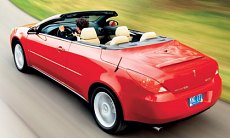|
Pontiac G6
Debut: 2004
Maker: General Motors
Predecessor: Pontiac Grand Am
|
|
 Globalization
is something you cannot avoid. Not even a car maker as big as General
Motors.
In the past, GM used to sell completely different cars in the USA and
Europe.
Time has changed. Its home market is being eaten up by Japanese and
Korean
cars, forcing it to give considerable incentives or simply cut price.
Under
such intensified competition, cost reduction became the No. 1 job.
Eventually,
this led to the cooperation between its European and American arms in
the
form of platform sharing. For the first time in many years, Chevrolet
and
Pontiac have cars derived from European-engineered platforms. And not
just
one but two platforms. GM called them Delta and Epsilon. Both were
developed
by Opel in Germany. The Delta is a small car platform and out of our
scope.
What we are talking now is Epsilon, the one that gave birth to Opel
Vectra
and Signum, Saab 9-3, Chevrolet Malibu and Maxx as well as Pontiac G6.
2 years from now the list will also include Saturn Aura. Globalization
is something you cannot avoid. Not even a car maker as big as General
Motors.
In the past, GM used to sell completely different cars in the USA and
Europe.
Time has changed. Its home market is being eaten up by Japanese and
Korean
cars, forcing it to give considerable incentives or simply cut price.
Under
such intensified competition, cost reduction became the No. 1 job.
Eventually,
this led to the cooperation between its European and American arms in
the
form of platform sharing. For the first time in many years, Chevrolet
and
Pontiac have cars derived from European-engineered platforms. And not
just
one but two platforms. GM called them Delta and Epsilon. Both were
developed
by Opel in Germany. The Delta is a small car platform and out of our
scope.
What we are talking now is Epsilon, the one that gave birth to Opel
Vectra
and Signum, Saab 9-3, Chevrolet Malibu and Maxx as well as Pontiac G6.
2 years from now the list will also include Saturn Aura.
Pontiac
G6
replaces the outgoing
Grand Am. With 4 million copies sold in the last 20 years, Grand Am was
the best selling model in the Pontiac division. But it was a bad car
indeed,
whose success was primarily based on low price and fleet sales. Over
the
years, Grand Am was only remembered for being forgettable. That's why
when
GM product director Bob Lutz (that lovely old man!) decided to revive
the
division with a new car, he dumped the name Grand Am without the
slightest
hesitation. But why he chose the name G6 is unsure. Yes, the fastest
version
of G6 has a Gearbox with 6 speeds, but the relationship with the name
is
just as thin as that. What I am sure is that G6 sounds pretty cool.
Even cooler is
the exterior
design. It is the first "Lutz's car" for GM - not designed by the old
man
of course, but was conceived by him from the beginning, designed and
developed
under his guidance. The G6 is a 4-door sedan but it looks more like a
coupe,
thanks to a cab-forward design, steeply raked windscreen and rear
window.
Its lines are sleek and simple. Surfaces are clean and tidy. That's a
clear
departure from the boy-racer-like, plastic-cladding-everywhere style of
previous Pontiacs. It is a refreshing sight from the mainstream Camry
and
Accord.
 The
cabin may not be as stylish as the exterior, but quality is OK while
space
is competitive. You can see the G6 as a stretched Opel Vectra. Its
2852mm
wheelbase is the longest possible of the Epsilon platform. That's also
152mm longer than Chevrolet Malibu. However, it is no wider than its
sisters.
That means while rear legroom is generous, 3 people sitting at the back
may not be as comfortable as Camry and Accord. The
cabin may not be as stylish as the exterior, but quality is OK while
space
is competitive. You can see the G6 as a stretched Opel Vectra. Its
2852mm
wheelbase is the longest possible of the Epsilon platform. That's also
152mm longer than Chevrolet Malibu. However, it is no wider than its
sisters.
That means while rear legroom is generous, 3 people sitting at the back
may not be as comfortable as Camry and Accord.
As
always, the
Vectra-based
chassis is immensely strong. To compensate with the wheelbase stretch,
Pontiac added a magnesium cross beam behind the dashboard. On the road,
the G6 feels rock solid and refined. Its strut and multi-link
suspensions
are tuned softer than its European cousins to deliver better ride that
GM believes American ask for. The electric power steering is also
lighter.
Unfortunately,
the revised
setting is also what magazines criticized most - they found the car
understeer
too much, the ride is somewhat floaty, the power steering overboosted
and
lacks feel. Admittedly, Vectra was never renowned for driving
excitement,
but it shouldn't be so bad. Part of the reason could be the heavyweight
iron-block V6 the G6 uses. The Detroit iron made the car nose-heavy
thus
deteriorated its dynamic balance. Another reason could lie on the way
Pontiac
tested and tuned its car. As I always say, chassis tuning is equally
important
as chassis design. Given a solid basis you still need to work hard to
get
the best out of it. Perhaps this is what Pontiac still lack of.
 If
we say the European-based chassis is disappointing, then the homegrown
3.5-litre push-rod V6 engine must be every bit predictable - you know
it
is unrefined and reluctant compare with rival's multi-valve V6s,
because
you have already read from Chevrolet Malibu which shares the same
engine.
In the heavier Pontiac G6, the combination of 200hp / 220 lbft and a
4-speed
automatic is even more struggling. The result is a sluggish performance. If
we say the European-based chassis is disappointing, then the homegrown
3.5-litre push-rod V6 engine must be every bit predictable - you know
it
is unrefined and reluctant compare with rival's multi-valve V6s,
because
you have already read from Chevrolet Malibu which shares the same
engine.
In the heavier Pontiac G6, the combination of 200hp / 220 lbft and a
4-speed
automatic is even more struggling. The result is a sluggish performance.
Later on, a
3.9-litre version
of the V6 will be added to the range. The additional capacity, variable
valve timing (unusual for push-rod engines) and variable intake
manifold
will lift its output to 240 horsepower and 245 lbft. But why not simply
give us the much better 24-valve V6 that Cadillac is using today? isn't
it more suitable to the sporting character of Pontiac?
Before
that, the
best engine
for G6 is perhaps the smallest one - the 170hp 2.4-litre Ecotec 16V.
This
all-alloy engine should improve handling a bit and its top-end
refinement
could be better than the old V6. Remember, it was engineered by Lotus.
Moreover, before Pontiac has found out the right chassis tuning, less
power
is likely to cause less embarrassment.
Overall
speaking,
although
G6 is a vast improvement over Grand Am, it still falls behind the
established
Japanese sedans for refinement and driving pleasure. If this is really
the first "Lutz's car", then I must admit I am disappointed.
|
| The
above report was last updated on 19 Jan
2005. All Rights Reserved. |
G6 Coupe GTP
|
Like
Honda Accord coupe or Toyota Camry Solara, Pontiac G6 Coupe is a
comfort-biased coupe. In other words, it is a G6 sedan with coupe's
clothes. Don't fooled by its attractive fastback, this car runs the
same very long wheelbase as its sedan sister. Inside, it offers the
rear passengers plenty of legroom, if not headroom.
 Handling and ride remains
uninspiring. Owing to a 62:38 weight distribution (blame to that
front-wheel-drive and iron-block V6), soft suspensions and
high-profile 225/50 tires, the coupe understeers heavily. Handling and ride remains
uninspiring. Owing to a 62:38 weight distribution (blame to that
front-wheel-drive and iron-block V6), soft suspensions and
high-profile 225/50 tires, the coupe understeers heavily.
The top GTP model employs GM's LZ9 3.9-litre V6. It is the first ever
push-rod engine employing variable valve timing technology. A hydraulic
cam phaser retards the camshaft timing by up to 25 degrees at low rev
to improve torque and emission, or advance the timing by up to
15 degrees at higher rev to quicken breathing. VVT also allows the
engine to use higher valve lift to enhance top end power without
sacrificing idle quality. As a result,
the 3.9 engine produces 240 horsepower at 6000 rpm and 241 lbft of
torque at 2800 rpm. A 2-stage variable intake manifold also helps
broadening the torque curve.
For smoothness and willingness, the push-rod V6 is incomparable to
modern multi-valve V6s, but when mated with a 6-speed manual gearbox it
takes just 6.5 seconds to go from 0 to 60 mph. Unfortunately, the
manual gearshift is very stiff. In fact, we cannot find any single area
really impressive. The G6, coupe or sedan, is not a car you will get
excited. |
| The
above report was last updated on 14 Feb
2006. All Rights Reserved. |
G6 Convertible
|
 
Coupe-cabriolets employing
retractable roof have been very popular in Europe in recent years, but
so far American car makers have yet to follow suit. This may be because they lack
vision or expertise in this technology. Anyway, Karmann, the German
convertible expert which produced the retractable roof for Renault
Megane CC and Nissan Micra C+C, has an office in the United States, and
it helped GM to develop a similar retractable roof mechanism for
Pontiac G6 Convertible.
 The car is based on G6 Coupe
and shares its handsome design. To keep price below US$30,000, it
employs a simple 2-piece metal roof. Unfortunately, this mean the roof
panels are large thus eat a lot of boot space. When the roof is down,
luggage volume reduces from 355 liters to a laughable 62 liters,
effectively eliminating the boot. In other words, you can either carry
luggage or enjoy
sunshine, mutually exclusive. The cabin is quite roomy. Thanks to the
same very long wheelbase as the sedan and coupe, there is adequate
legroom for adults at the back, though when the roof is closed rear
headroom becomes limited. The car is based on G6 Coupe
and shares its handsome design. To keep price below US$30,000, it
employs a simple 2-piece metal roof. Unfortunately, this mean the roof
panels are large thus eat a lot of boot space. When the roof is down,
luggage volume reduces from 355 liters to a laughable 62 liters,
effectively eliminating the boot. In other words, you can either carry
luggage or enjoy
sunshine, mutually exclusive. The cabin is quite roomy. Thanks to the
same very long wheelbase as the sedan and coupe, there is adequate
legroom for adults at the back, though when the roof is closed rear
headroom becomes limited.
 Scuttle shake is inevitable for
the long wheelbase chassis. On rough pavement, vibration is visible at
the windscreen header as well as steering wheel, and detectable through
the seats. It's not as bad as older American convertibles, but
apparently its chassis rigidity is not up to the level of Volvo C70.
Furthermore, the roof conversion added some 160 kilos to the already
hefty GTP Coupe, dampening the performance offered by the 3.9-litre ohv
V6. The push-rod engine used to be modest, now its output is even
reduced from 240hp to 227hp in the Convertible without giving any
reasons. Besides, GM thought convertible drivers don't prefer to shift
gears by themselves, so it offers only a 4-speed automatic. Both the
motor and transmission feel outdated. Scuttle shake is inevitable for
the long wheelbase chassis. On rough pavement, vibration is visible at
the windscreen header as well as steering wheel, and detectable through
the seats. It's not as bad as older American convertibles, but
apparently its chassis rigidity is not up to the level of Volvo C70.
Furthermore, the roof conversion added some 160 kilos to the already
hefty GTP Coupe, dampening the performance offered by the 3.9-litre ohv
V6. The push-rod engine used to be modest, now its output is even
reduced from 240hp to 227hp in the Convertible without giving any
reasons. Besides, GM thought convertible drivers don't prefer to shift
gears by themselves, so it offers only a 4-speed automatic. Both the
motor and transmission feel outdated.
The
suspension of G6 Convertible is set softer than the coupe, so there is
a lot of understeer and roll. In addition to the increased weight and
loss of chassis stiffness, handling is hardly sporty, driving fun is
limited. Its priority is put on ride comfort and predictable driving
manner.
Next year, Pontiac will offer it the Holden-developed 3.6-liter DOHC
VVT V6 engine (252hp) and a new 6-speed automatic gearbox. This could
improve the car markedly, but even then it will be difficult to compare
with European offerings. However, if you want a coupe-cabriolet with
real 4-passenger accommodation and costing below US$30,000, there is no
alternative. |
| The
above report was last updated on 8 Aug 2006. All
Rights Reserved. |
|
|